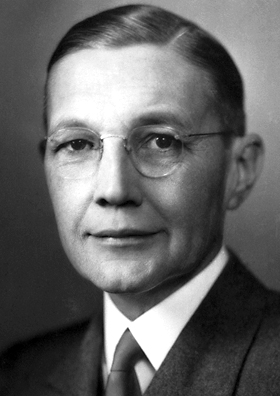Herbert Spencer Gasser facts for kids
Quick facts for kids
Herbert Spencer Gasser
|
|
|---|---|

Gasser in 1944
|
|
| 2nd Director of Rockefeller Institute | |
| In office 1935–1953 |
|
| Preceded by | Simon Flexner |
| Succeeded by | Detlev Bronk |
| Personal details | |
| Born | July 5, 1888 Platteville, Wisconsin, U.S. |
| Died | May 11, 1963 (aged 74) New York City, U.S. |
| Alma mater | University of Wisconsin–Madison Johns Hopkins School of Medicine |
| Known for | Action potentials Nerve fiber analysis |
| Awards | Nobel Prize for Physiology or Medicine (1944) Foreign Member of the Royal Society (ForMemRS) (1946) |
| Scientific career | |
| Fields | Physiology |
| Institutions | Rockefeller University Cornell University Washington University in St. Louis |
| Academic advisors | Joseph Erlanger |
Herbert Spencer Gasser (born July 5, 1888 – died May 11, 1963) was an American scientist. He was a physiologist, which means he studied how living things work.
In 1944, he won the Nobel Prize with Joseph Erlanger. They won for their important discoveries about how nerve signals (called action potentials) travel along nerve fibers. This work helped us understand how our brains and bodies communicate.
Contents
Early Life and Education
Herbert Spencer Gasser was born in Platteville, Wisconsin, in the United States. His father was a doctor from Austria. His mother had family from New England and Germany.
Gasser first went to State Normal School in Platteville. In 1907, he started studying at the University of Wisconsin. He finished his first degree in zoology very quickly, in just two years.
Medical Studies
In 1909, Gasser began medical school at the University of Wisconsin. There, he studied physiology with Joseph Erlanger. He also studied pharmacology, which is the study of medicines.
Even while he was still a student, Gasser became an instructor in pharmacology in 1911. Since the University of Wisconsin only offered the first part of medical training, Gasser moved. In 1913, he transferred to Johns Hopkins School of Medicine. He earned his medical degree in 1915. After graduating, he returned to the University of Wisconsin as an instructor.
In 1916, Gasser moved to Washington University to work in the physiology department.
Contributions During Wartime
When the United States joined World War I, chemical weapons were being used. Gasser was asked to use his knowledge of the human body to help. In the summer of 1918, he joined the Armed Forces Chemical Warfare Service. This group worked on protecting soldiers from chemical attacks.
After the war ended in November 1918, Gasser went back to Washington University. He became a professor of pharmacology in 1921.
Research and Leadership
From 1923 to 1925, Gasser traveled to London, Paris, and Munich to study. He had a special grant from the Rockefeller Foundation. His goal was to help improve medical education in the United States. After these studies, he returned to Washington University.
Moving to New York
In 1931, Gasser moved to New York City. He became a professor of physiology at Cornell Medical College. After four years there, he took on a very important role.
In 1935, he became the second director of the Rockefeller Institute. This institute was a famous place for scientific research. He stayed in this leadership position until 1953.
Nobel Prize Discovery
In 1936, Gasser and his colleague Erlanger gave a series of lectures. They shared their research on how human nerve cells work. This work was very important and led to their big recognition.
In 1944, Gasser and Erlanger jointly received the Nobel Prize. Gasser used his prize money to continue his research into nerve signals.
Later Life and Legacy
Even after he retired from the Rockefeller Institute in 1953, Gasser kept doing research. He wrote over 100 scientific papers during his life. These papers shared his discoveries with other scientists.
Herbert Spencer Gasser passed away in New York City on May 11, 1963. His work greatly advanced our understanding of the nervous system.
See also
 In Spanish: Herbert Spencer Gasser para niños
In Spanish: Herbert Spencer Gasser para niños

